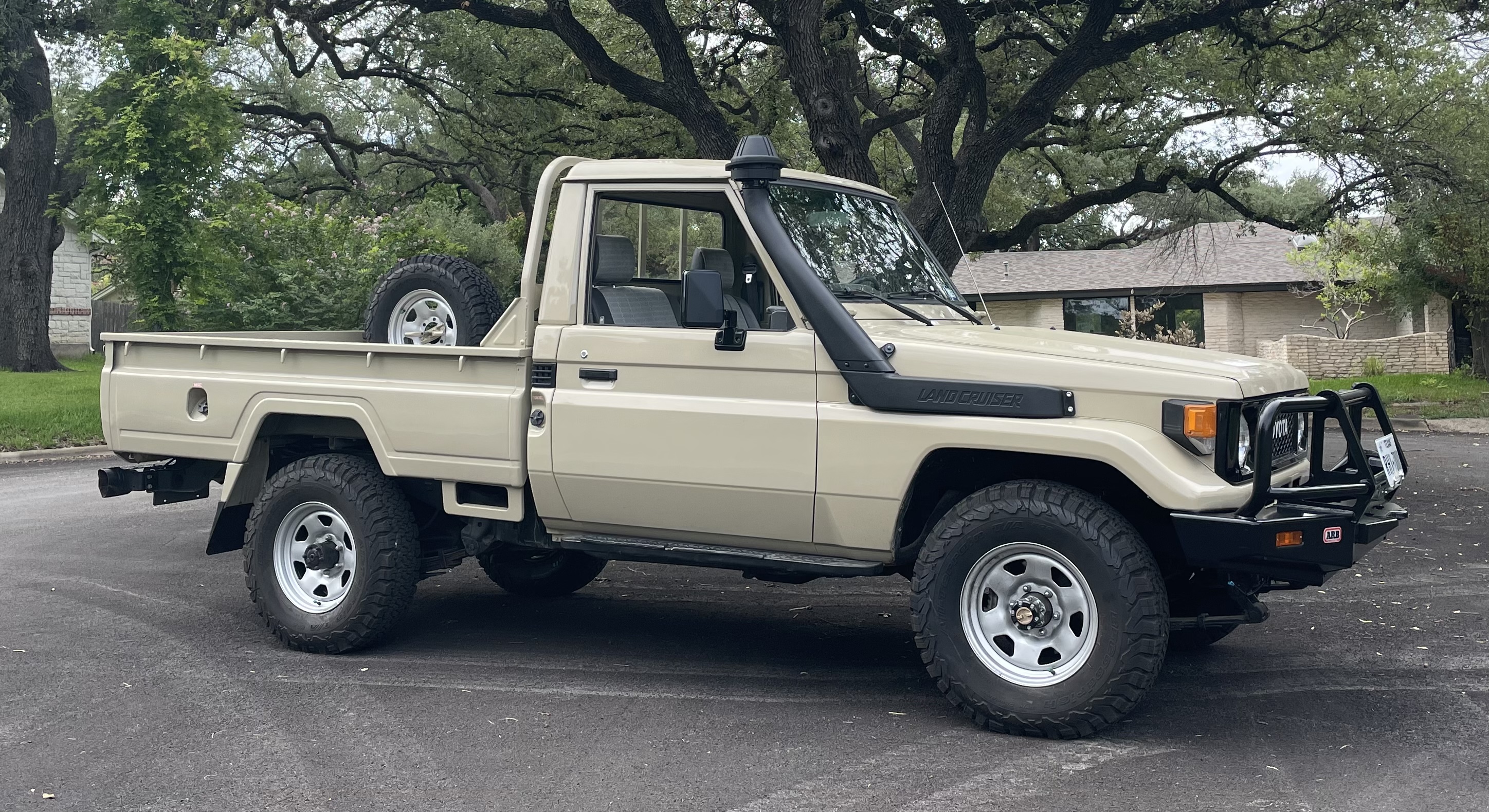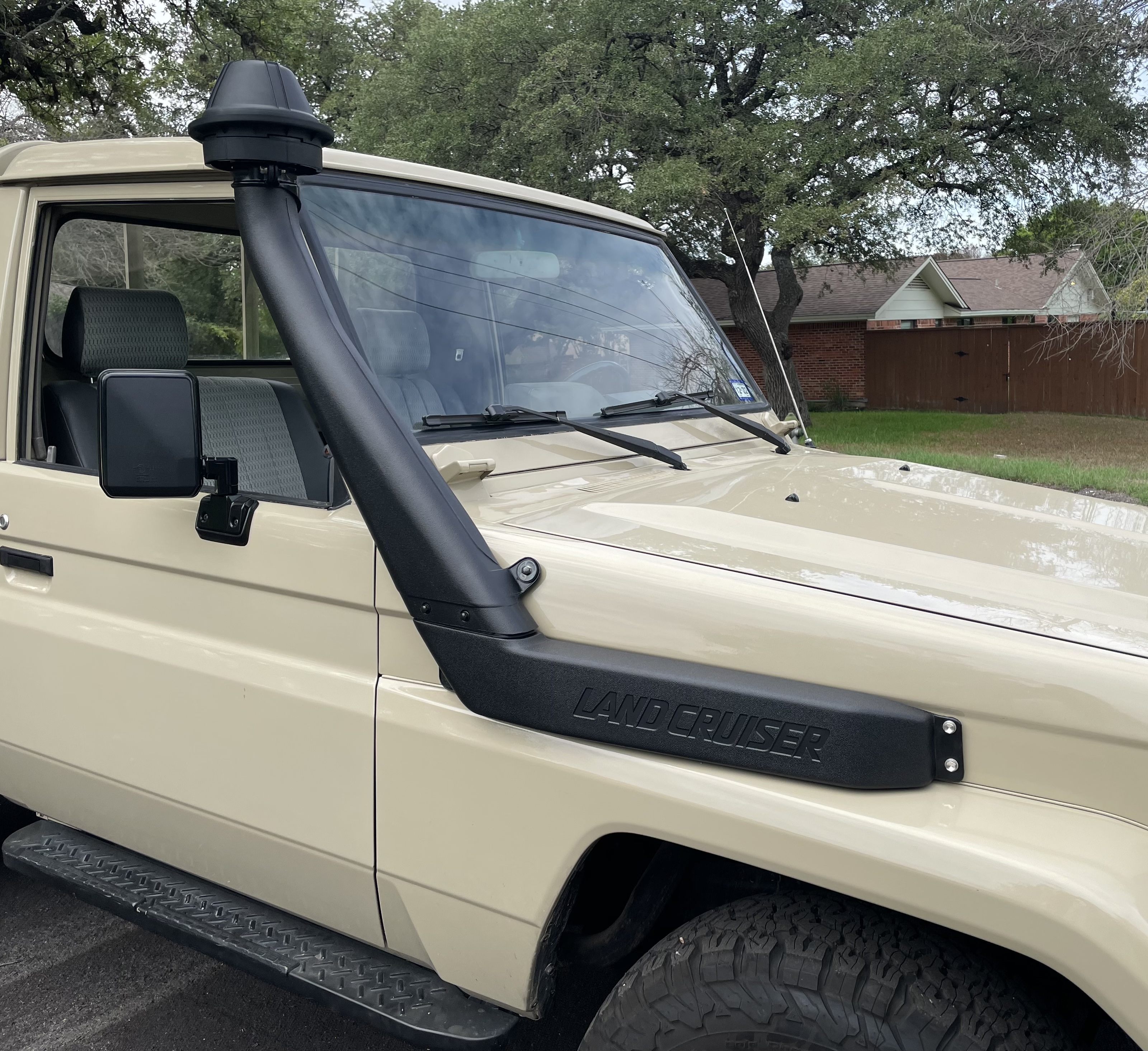Navigation
Install the app
How to install the app on iOS
Follow along with the video below to see how to install our site as a web app on your home screen.
Note: This feature may not be available in some browsers.
More options
Style variation
You are using an out of date browser. It may not display this or other websites correctly.
You should upgrade or use an alternative browser.
You should upgrade or use an alternative browser.
Oem snorkel install.
- Thread starter divemedic
- Start date
This site may earn a commission from merchant affiliate
links, including eBay, Amazon, Skimlinks, and others.
More options
Who Replied?This was such a handy thread I figured I'd post the parts info here as well...
OEM snorkel parts for the narrow nose 70-series trucks... note the Toyota parts system calls it a cool air intake.
Columns are Part Name, Quantity, OEM Part Number

And finally, the washer bottle:
Washer Bottle Assembly (w/ Snorkel) - 85315-60190 x1
OEM snorkel parts for the narrow nose 70-series trucks... note the Toyota parts system calls it a cool air intake.
Columns are Part Name, Quantity, OEM Part Number
And finally, the washer bottle:
Washer Bottle Assembly (w/ Snorkel) - 85315-60190 x1
loeky
SILVER Star
Like so...

Ignore the red "x" marks, those are the former emblem holes I'm going to weld shut.
I went ahead and did the whole rivnut/nutsert thing for mine as well.


Quick thanks @Honger for the photos of this - gave me a clue for how to cut out the bigger air hole from out to inside.
Will measure/drill/mount the external snorkel, then use the inside metal piece in reverse to mark/cut the hole as the forward bolt holes match up from the outside to inside.
Will Van
GOLD Star
Joel, we have already spoken. And I know you have already installed your snorkel. But I thought I would answer this question more thoroughly for others who might search this thread during an install....one things puzzles me about how it installs.

Does the body panel sandwich between 53284G and 53964 (the red arrow)?
OR
Does the body panel sandwich between 53964 and 17911A (the green arrow)?
Full Disclosure: I am installing an OEM Toyota snorkel on my 1996 HZJ75 Pickup. As of the time of this writing I have not received all the parts nor completed the install. So take this info with a grain of salt until I can confirm everything after installation.
The question is - How does the lower plastic section of the snorkel, the steel backing plate, and the rubber intake hose mount onto the truck's fender?
I stumbled on this photo of a Japanese gentleman cleaning the paint on a HZJ77 with an OEM snorkel removed. You can clearly see there are two mounting studs at the front section of the fender (circled in yellow).

This is also consistent with the exploded view of the parts diagram. Circled in red is Toyota part number 90176-08029 (x2), which are nuts (not bolts) for the front two studs. (I realize everyone just uses riv-nuts to mount their snorkels. I am just explaining the OEM setup).


This means that the lower plastic section of the snorkel, the steel backing plate, and the rubber intake hose (at least the flange portion) all mount on the exterior of the fender.
As mentioned earlier in this thread, the steel backing plate has adhesive on one side. You can see the tape in this photo.

You glue the rubber intake hose (green) to the steel backing plate (blue), then slide the round portion of the hose through the fender into the interior of the engine bay. The steel backing plate and rubber hose then hang on the two studs (yellow) while you install the 3rd fastener and mount the lower section of the plastic intake.
Clear as Mud?
Also, @Honger, I know you welded the holes shut from the old "Land Cruiser" badge on the fender. But Toyota just uses plastic plugs to fill the holes. You can see them in the paint-cleaning photo. And they're called out in the exploded diagram (Toyota PN: 90333-20001). Way to go above and beyond!
Last edited:
Good information. The upper fenders are indeed different for "w/Schnorkel Type air intake" and without.
Will Van
GOLD Star
If you have it, would you mind sharing the part number for "w/ Schnorkel Type air intake" right upper fender?Good information. The upper fenders are indeed different for "w/Schnorkel Type air intake" and without.
Edit: Maybe part number 53303-90K09? But has that PN has been superseded?
Last edited:
53303-60060
Man... I have to redo mine now...Joel, we have already spoken. And I know you have already installed your snorkel. But I thought I would answer this question more thoroughly for others who might search this thread during an install.
Full Disclosure: I am installing an OEM Toyota snorkel on my 1996 HZJ75 Pickup. As of the time of this writing I have not received all the parts nor completed the install. So take this info with a grain of salt until I can confirm everything after installation.
The question is - How does the lower plastic section of the snorkel, the steel backing plate, and the rubber intake hose mount onto the truck's fender?
I stumbled on this photo of a Japanese gentleman cleaning the paint on a HZJ77 with an OEM snorkel removed. You can clearly see there are two mounting studs at the front section of the fender (circled in yellow).

This is also consistent with the exploded view of the parts diagram. Circled in red is Toyota part number 90176-08029 (x2), which are nuts (not bolts) for the front two studs. (I realize everyone just uses riv-nuts to mount their snorkels. I am just explaining the OEM setup).


This means that the lower plastic section of the snorkel, the steel backing plate, and the rubber intake hose (at least the flange portion) all mount on the exterior of the fender.
As mentioned earlier in this thread, the steel backing plate has adhesive on one side. You can see the tape in this photo.

You glue the rubber intake hose (green) to the steel backing plate (blue), then slide the round portion of the hose through the fender into the interior of the engine bay. The steel backing plate and rubber hose then hang on the two studs (yellow) while you install the 3rd fastener and mount the lower section of the plastic intake.
Clear as Mud?
Also, @Honger, I know you welded the holes shut from the old "Land Cruiser" badge on the fender. But Toyota just uses plastic plugs to fill the holes. You can see them in the paint-cleaning photo. And they're called out in the exploded diagram (Toyota PN: 90333-20001). Way to go above and beyond!
I didn't bolt my snorkel in from the outside. I put bolts in from behind and used the OEM acorn nuts... so at least I got that right.
But the correct way makes a lot more sense.
Will Van
GOLD Star
Thank you.53303-60060
Man... I have to redo mine now...
I didn't bolt my snorkel in from the outside. I put bolts in from behind and used the OEM acorn nuts... so at least I got that right.
But the correct way makes a lot more sense.
Sorry, I didn’t mean to make more work for you!
Great tech 
Will Van
GOLD Star
Here are the final results.




FJBen
SILVER Star
Looks great!
One of My snorkel bolts doesn’t tighten up really tight. When I do a few maintenance items on it soon, I’m adding it to the list to see why my acorn won’t cinch down.
One of My snorkel bolts doesn’t tighten up really tight. When I do a few maintenance items on it soon, I’m adding it to the list to see why my acorn won’t cinch down.
While this data applies to the V8 I would assume it’s applicable to all Toyota Diesel engines. I found it to be very interesting.

While this data applies to the V8 I would assume it’s applicable to all Toyota Diesel engines. I found it to be very interesting. View attachment 3104929
I’d like to see these all ranked against the standard, non-snorkel intake. Yes, a ram-head is going to be better than the top hat… but is the OEM snorkel with top hat an increase over the OEM inside-the-fender arrangement?
FJBen
SILVER Star
I’d like to see these all ranked against the standard, non-snorkel intake. Yes, a ram-head is going to be better than the top hat… but is the OEM snorkel with top hat an increase over the OEM inside-the-fender arrangement?
All I know, from my non-scientific but real work test, is that indeed the ram mounts flow more. As soon as I put the top hat, mine started collapsing intake hoses, with the stock ct26.
With the he221, I used 3” intake, plus the FZJ80 3.5” air filter lid and I can still cause something to shut or collapse. I’m wondering if it’s the shutdown butterfly now. I have only small silicon join sections, and aluminum pipe for intake.
Either way, something on my setup is choking out and hard pulls in 4th.
I figured every little bit helps and converted to the Rams Head. 
I am not satisfied with “slowly gathering momentum”, I want to slowly gather momentum with authority.
I am not satisfied with “slowly gathering momentum”, I want to slowly gather momentum with authority.
Last edited:
I’d like to see these all ranked against the standard, non-snorkel intake. Yes, a ram-head is going to be better than the top hat… but is the OEM snorkel with top hat an increase over the OEM inside-the-fender arrangement?
I am not getting a snorkel but I will say I have always wondered this. My guess there is not going to be much improvement if any at all.
I am not getting a snorkel but I will say I have always wondered this. My guess there is not going to be much improvement if any at all.
Hello,
With the improvements mentioned by the article above, a re-map of the ECU is mandatory to deal with the additional power. Or injection pump recalibration in older engines. It sounds too good to be true to me.
In my opinion, a raised air intake is a way to feed cleaner air to the engine in dusty environments. And a way to protect the engine during river crossings.
Juan
Similar threads
Users who are viewing this thread
Total: 1 (members: 0, guests: 1)
